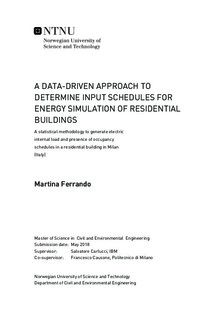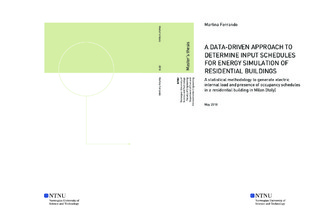| dc.description.abstract | Ensuring that the energy need predicted by energy modelling corresponds to the actual energy need, will be strictly important in the close future with the increase in the number of low-energy buildings and retrofitting projects and with the refining of regulations. Occupant behaviour is indicated as one of the biggest uncertainties in energy modelling. Thus, an improvement in the description of the occupant behaviour is needed. This thesis discusses one of the possible methods to analyse the monitored data and to apply a deduction approach to improve the energy model from the point of view of the occupant behaviour. A comprehensive data-driven approach for the assessment of the impact of occupant behaviour on the energy need is proposed. The presented methods are applied and validated through a case study regarding a residential building block in Milan, Italy.
In the first phase, a clustering methodology for creating five representative electricity daily load profiles is proposed. The implementation of machine learning techniques emerged from literature as the appropriate tool for the task. A two-level approach is used composed by a Self-Organizing Map, a Neural Network technique, coupled with the k-means algorithm, a classic machine learning method. The k-Nearest Neighbour algorithm is implemented to extend the results to the whole year. In the second phase, a detection method is proposed to estimate the presence of occupants in the household. The technique is based on the analysis of the electricity consumption data to detect the occupancy through the exploitation of the k-Nearest Neighbour algorithm. The extension to the whole year relies on the clustering obtained in the previous task. The resulted presences and electric load clusters emerged with different daily profiles, that can be ascribed to different types of families and habits. Highlighting three scenarios of energy spenders: energy-aware user, standard user, and energy-intensive user. In the last phase, the schedules generated in the previous steps are used to assess the impact of the occupant behaviour on the heating energy need during a year and the modelled result is compared with the real registered data. | |

